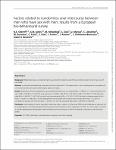Factors related to condomless anal intercourse between men who have sex with men: results from a European bio-behavioural survey
Sherriff, N. S.
Jones, A. M.
Mirandola, M.
Gios, L.
Marcus, U.
Llewellyn, C.
Rosinska, M.
Folch, C.
Dias, S.
Toskin, I.
Alexiev, I.
Kühlmann-Berenzon, S.
Sialon II Network
Background
Relationship status is an important factor associated with condomless anal intercourse (CAI) amongst men who have sex with men (MSM).
Methods
A multi-centre bio-behavioural survey with MSM was conducted in 13 European cities (n = 4901) exploring factors associated with CAI via bivariate and multivariate multilevel logistic regression analyses.
Results
Likelihood of CAI with casual partners was associated with being ‘out’ to a majority (AOR = 1.19;95% CI 1,1.42); knowing their HIV status (AOR = 1.86; 95% CI 1.25,2.76); using substances (1–2 AOR = 1.39; 95% CI 1.16,1.63, 2+ AOR = 1.81; 95% CI 1.35,2.42); being older (AOR = 0.98; 95% CI 0.97,0.99); successful sero-communication (AOR = 0.79; 95% CI 0.67,0.94); and, not having a recent HIV test (AOR = 0.78; 95% CI 0.66,0.92). CAI with steady partners was associated with successful sero-communication (AOR = 2.72; 95% CI 2.72,3.66); not having a recent HIV test (AOR = 1.26; 95% CI 1.09,1.46), and; being older (AOR = 0.99; 95% CI 0.98,0.99).
Conclusions
Understandings of partner type and/or relationship status in relation to CAI amongst MSM can potentially play an important role in the development of culturally appropriate HIV/STI prevention and risk-reduction efforts targeting at-risk MSM. Our results speak to the need to consider segmented and tailored public health and health promotion initiatives for MSM with differing CAI behaviours and relationship profiles.
Dateien zu dieser Publikation

